This is a Nicca III-L, a 35mm rangefinder camera originally developed in 1958 by Nicca Camera Co. Ltd. of Japan and upon it’s release, sold under Nicca’s ownership by Yashica. Although two more Nicca built cameras continued to be sold with Yashica branding, the III-L is the considered the last true Nicca camera as it’s entire development happened prior to Yashica’s acquisition. The Nicca III-L is an evolution of the company’s earlier Leica-copy bottom loading rangefinders, but changes the appearance, and adds a number of improvements never before seen on a Nicca camera, such as a combined coincident image rangefinder, automatic resetting exposure counter, and a back plate film advance lever. The camera was produced for a very short time and is considered highly collectible today.
Film Type: 135 (35mm)
Lens: 5cm f/2 Nippon Kogaku Nikkor-HC coated 6-elements in 4-groups
Lens Mount: M39 Leica Thread Mount
Focus: 1.5 feet to Infinity (3.5 feet to infinity rangefinder coupled)
Viewfinder: Combined Coincident Image Coupled Rangefinder
Shutter: Cloth Focal Plane
Speeds: T, B, 1 – 1/1000 seconds
Exposure Meter: None
Battery: None
Flash Mount: Cold shoe and M and X Flash Sync
Other Features: None
Weight: 799 grams, 582 grams (body only)
Manual: http://www.cameramanuals.org/minolta_pdf/minolta_autowide.pdf
How these ratings work |
The Nicca III-L is a gorgeous camera that upgrades earlier models with a more modern coincident image rangefinder, an automatic resetting exposure counter, and new cosmetics, but isn’t functionally any better than earlier models. You’re going to pay extra to get one of these, so if you want what I consider to be one of the best looking LTM cameras, go for it, but don’t expect that extra money to get you a better camera. | ||||||
| Images | Handling | Features | Viewfinder | Feel & Beauty | History | Age | |
| 2 | 2 | 1 | 2 | 2 | 1 | 30% | |
| Bonus | none | ||||||
| Final Score | 13.0 | ||||||
History
Copies of the Leica II and III are about as ingrained into the history of 35mm cameras as Kodak is to film. With an abundance of models from countries all over the world, from the Soviet Union, the United States, England, and even France, everyone was making cameras that in some way copied something from Oskar Barnack’s original design.
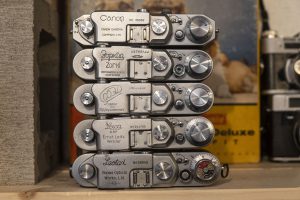
Of all the countries where Leica copies were made, by far, Japan did it the best, and with the most variety. Some companies like Canon and Minolta would take the original Barnack design and make changes to it from the very beginning. Canon’s first attempt at a Leica inspired 35mm rangefinder used a completely different mount, and later versions used a rotating prism to alter the focal length of the viewfinder. Minolta added features like a hinged back, combined coincident rangefinder, and different cosmetics. Other Japanese companies however, were content sticking very close to the original formula. Companies like Leotax, Tanack, and Nicca created their own versions of the Leica III that apart from the name engraved to the top plate, would be very difficult to distinguish from the real thing at a glance.
Of all the Japanese Leica copies, the most successful was Canon as their string of Leica inspired rangefinders spanned four decades, however the second most successful is probably Nicca. Outside of camera collectors, Nicca is a brand that’s lately forgotten today as despite their success at making 35mm rangefinders, they didn’t do anything else and like most companies with a single product offering, they failed to compete in a highly competitive and evolving camera market.
Nicca’s history starts like many other Japanese companies, with Canon and Nikon, or more specifically Seiki Kogaku and Nippon Kogaku. I’ve covered both Canon’s and Nikon’s history many times on this site, so if you’d like to learn more, check out these articles for a more detailed look back.
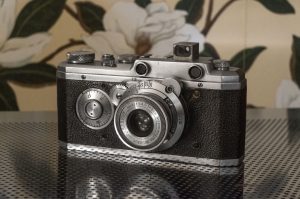
Nicca’s story starts with a Japanese optical engineer named Kumagai Genji who joined Canon sometime between 1936 and 1940 to help work on Canon’s Hansa Canon and other Canon rangefinders. Genji’s exact contributions to Canon are unknown, but whatever it was, it was short lived, as around 1940, he would leave to start his own company.
The circumstances in which he left Canon, or what his new company did are unclear. Some sources suggest that Kumagai simply left the company voluntarily to start a new company called Kōgaku Seiki-sha, meaning Optical Precision Company to focus on a new Japanese Leica copy, others suggest that a company called Ōmiya Shashin-yōhin K.K. who distributed the Hansa, ordered Kumagai and seven other Seiki Kogaku employees to setup a Canon repair shop for the Hansa and Canon S and J models that were in production. The similarity between the names Kogaku Seiki-sha and Seiki Kogaku was likely intentional, which leads me to believe the Canon repair shop version is the correct one as the new name was likely chosen so that people would associate them with Canon products. Whichever of these is true isn’t all that important as both agree that by 1940, Kumagai Genji was no longer affiliated with Seiki Kogaku.
The Hansa and new Canon models sold modestly to the public and although were positively received, production was slow and each had a lens mount that was difficult to make and incompatible with anything coming from Germany.
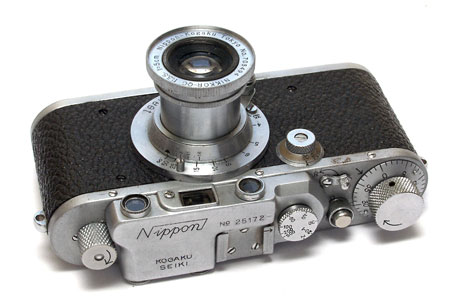
In 1941, Kōgaku Seiki-sha would be ordered by the Japanese military to produce an exact copy of the Leica III that could be built quickly and would use Leica screw mount lenses. In less than a year, a new patriotically named Nippon camera was created. The Nippon was nearly identical to the Leica III with one exception being that the rangefinder magnification was 1x instead of the Leica’s 1.5x. Otherwise, it was fully compatible with all Leica screw mount lenses. A later variant of the Nippon was produced without a rangefinder or slow speeds as well, but it’s even rarer than the first version.
Information about the Nippon camera is scarce and it’s name is confusingly similar to that of Nippon Kogaku, despite being produced by a different company. I am unsure if the Nippon was produced exclusively for military use, or if they were ever sold to the public. All sources that I’ve found suggest that very few Nippon cameras were ever produced, possibly less than 1000 total, and if they were used by the Japanese military, it’s likely many were destroyed during the war.
In 1948, Kōgaku Seiki-sha would change it’s name to Nippon Camera Works which they would use for only one year, changing it’s name once again in 1949 to Nicca Camera Works. The name “Nicca” likely came as a combination of “Nippon” and “camera”, similar to how Leica is a combination of “Leitz” and “camera”.
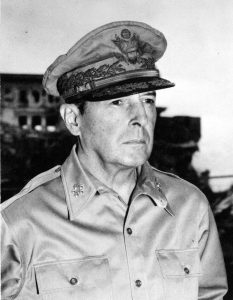
In the years after World War II, Japan’s economy was in shambles and resources were very hard to come by. By orders of General Douglas MacArthur, all Japanese industry had to be approved by the American Occupied Forces before anything could be made. The United States had an interest in rebuilding Japan’s economy and in order to do that, they needed an infusion of money, so products that were deemed easy to sell were approved with regularity.
The Nicca, being nearly identical to a real Leica was seen as an easy thing to sell, so in 1948 Nippon Camera Works would begin production of civilian Nicca cameras. Although Nippon Kogaku had gained favor by American forces and photographers for their lenses, they weren’t yet known for their cameras leaving only Nicca and Canon as two of the only Japanese camera makers exporting their products out of Japan. The Nikon rangefinder wouldn’t start to gain significant recognition until the release of the Nikon S2 in 1955.
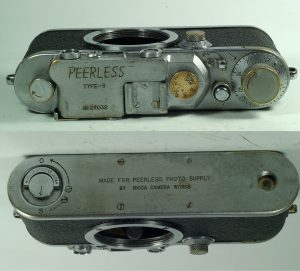
In 1949, Nicca would produce their first camera to gain some popularity. The Nicca Type 3 was a more refined version of the original Nicca camera. The Type 3 was sold branded both with the Nicca name, but also with the name of some of it’s distributors. One such example was for cameras sold by Peerless Camera in New York City. These “Peerless Niccas” are extremely rare but did exist.
In 1951, the Nicca Type 3 would be renamed the Nicca IIIA, and a new version with flash synchronization called the Nicca IIIB was released. These two new cameras were important as also in 1951, Nicca struck a deal with the Sears, Roebuck, & Company, a very large American department store retailer. Under this new deal, Nicca would produce cameras for Sears under their own house brand, Tower. The first Nicca sold under this deal was the Tower 35 Type III.

In the ad from the 1952 Sears Camera Catalog, the Tower 35 Type III sold with a case and Nikkor f/2 and f/1.4 lenses for $175 and $298 respectively. When adjusted for inflation, these compare to $1700 and $2900 today. Although steep in price, in a January 1952 ad for Peerless Camera in New York City, a brand new Leica IIIC with f/2 Summitar had a list price of $350, nearly twice that of the Tower.
With the release of the Tower 35 Type III, Sears would become Nicca’s primary distributor in the United States. This partnership would continue until the end of the decade when Nicca would be absorbed into Yashima and stop producing cameras under their own name.
As each new Nicca model was released, an equivalent Tower version would as well. For the most part, the changes to each new Nicca model were incremental with the most significant upgrades being flash synchronization, a change to the film reminder dial on the advance knob, and in the Type-4, the addition of a top 1/1000 shutter speed.
In 1955, Nicca would make it’s first of a couple significant changes to the original Leica III design it was ordered to copy in 1941 with the release of the Nicca Type-5. The first was a Leica M3 style hinged door on the back of the camera which would allow the photographer to see both the film plane and the film as he or she loaded it into the camera. In 1957, an updated Model 3-F would add a film advance lever, relocated shutter release button, and rewind push button, and in 1958, the III L a combined coincident image rangefinder.
By the late 1950s, despite having a seemingly strong relationship with Sears, Nicca ran into financial trouble. Their Nicca rangefinders were the only products the company made, and with a dwindling demand for screw mount 35mm rangefinders, their sales slowed to a crawl.
At first, when Nicca started to struggle, no one was interested in them as the Japanese optical market was flooded with camera companies. But then another struggling Japanese company, Yashima Optical Ind. Co., Ltd. stepped in.
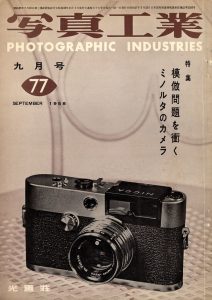
Yashima’s founder, Yoshimasa Ushiyama, had realized that Single Lens Reflex cameras were increasing in demand and that Yashima would need to produce their own SLR if they were to stay competitive. By this time, Asahi Pentax and Miranda already had their own SLRs with models from Minolta, Nikon, and Canon coming soon. Without much experience in making 35mm cameras and no experience with focal plane shutters, Yashima sensed an opportunity to acquire a company that already had this experience and in May 1958 bought Nicca before they filed for bankruptcy, which meant they acquired all of their technology and knowledge at a bargain price.
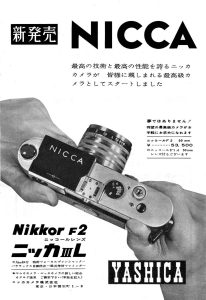
Around the time of Nicca’s acquisition by Yashima, they were hard at work at what would become the company’s most unique camera to date. This new model would make significant changes to the design of all previous Nicca models, with a new two tone and completely redesigned top plate, coincident image coupled rangefinder, and an automatic resetting exposure counter. The new camera would still use the M39 Leica Thread Mount, but otherwise would be an all new camera.
The new camera wouldn’t be ready for release until June 1958, and despite now being owned by Yashima who themselves had recently officially changed it’s name to Yashica, the new model called the Nicca III-L would be last Nicca branded camera released by the company. Another model, called the Yashica YF would have a Nicca name plate still on the camera, but would be sold as a Nicca camera.
I’ve found no evidence the Nicca III-L was sold outside of Japan as no American publications or year end model wrap ups mention it.
Edit 6/27/2022: After publishing this review, I was contacted by Yashica/Nicca expert Paul Sokk who let me know that although the Nicca III-L was a Japanese only model, there does exist a Tower variant of it, possibly suggesting that Sears either did sell it, or considered selling it in the United States. Strangely, no catalogs or advertisements of the era show this camera being for sale, nor does it have any known official Tower model number, so this could have possibly been a proof of concept for Sears which they declined to offer, or perhaps was dropped after the Yashica merger. No one really knows the history behind this Tower version of the Nicca III-L, but it does exist.
In Japan, the Nicca III-L was advertised with a Nikkor 50mm f/2 lens for ¥53,500 which is more than double the price of ¥23,800 asked for a Yashica YE and on par with a Minolta SR-2 SLR, both advertised in a 1959 issue of Asahi Camera. Had the camera been sold in the US, it’s possible it’s similar price to the SR-2 in Japan would translate to a $249.50 price here, but that’s just a guess. Such a high price, and nothing really new when it comes to interchangeable lens 35mm rangefinders likely would have made it a difficult sell here.
A combination of new ownership, lack of distribution, and a comparatively high price, the Nicca III-L was not produced for long. Shortly after it’s release, Yashica would release two additional models at a lower price than the III-L called the Yashica YE and YF, both rebadges of previous Nicca models. It was clear Yashica’s desire was to start making single lens reflex cameras, and Nicca’s previous experience with focal plane shutters helped them get closer to releasing what would become the Yashica Pentamatic in 1960, so the company’s interest in 35mm interchangeable lens rangefinders was short lived.
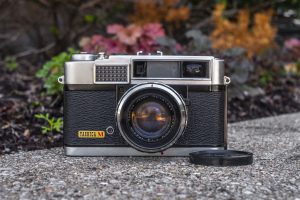
After Yashica’s pivot to SLRs, no new interchangeable lens cameras would be released. Not wanting to give up on people not yet interested in SLRs, Yashica would continue to produce quite a few fixed lens models with leaf shutters starting with the Yashica 35, continuing into the Lynx and Minister lines, and eventually the highly successful Yashica Electro series starting in 1966.
Today, all interchangeable lens 35mm rangefinders are desirable by users and collectors alike, regardless of how close they are to the original Leica formula. For those wanting a Leica-like experience without the Leica-like price can still find values in early Nicca and Leotax models. For those wanting something a little different, Canon and later Nicca models offer some nice improvements over the original formula, and for those who want something completely different, there’s the III-L.
These cameras were well built, and assuming they’ve been taken care of over the years, are usually still good shooters today. In the event you find one that needs service, the internal workings are still close enough to the Leica, that most people who can service them, will also take on the Japanese copies.
In the event are new to collecting or using rangefinder cameras, the Nicca III-L is difficult and expensive to find, so probably wouldn’t be a good first choice, but if one ever comes your way, they’re worthwhile cameras to own.
My Thoughts
If you use this site’s search function and search for the word “Nicca”, you’ll get well over a dozen search results, most notably the Tower 45 which was a rebadged Nicca, but also referencing the company in a variety of other reviews I’ve written. Strangely, I’ve never reviewed a proper Nicca branded camera, so when I had a chance to review this III-L, I thought it would make for a worthy article.
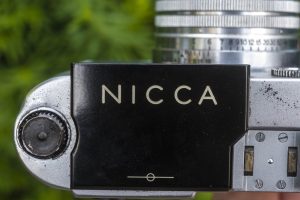
This Nicca is from the collection of Robert Rotoloni, who is most famously the president of the Nikon Historical Society and all around Nikon guru, but for those who know him, Robert is also a fan of other types of cameras including Canon rangefinders and SLRs, the KW Praktina, and many different subminiatures. This Nicca is on long term loan from him.
At just under 800 grams, the III-L is a little heavier than the Tower 45, which itself is a tad heavier than a Leica III, although truth be told, even handling each of the three side by side by side, whatever difference in weight the scale says, I can’t feel it.
There are those who feel the feature set of the Leica III is already perfect, and that all the changes companies like Canon and Nicca made to the basic formula are unnecessary, but I don’t think anyone can debate is the camera’s beauty. The two tone black and chrome top plate is very distinct and unlike any other Leica Thread Mount camera out there.
Up top, the large black and white name plate dominates the camera, with a slight overhang over the front edge of the camera, evoking somewhat of an American automobile design cue. Riken chose a similar front overhang with the Anscomark M, which also has strong hints of American automobile design of the era.
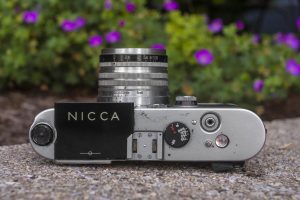
To the left of the black name plate is a pop up rewind knob, which neatly fits into a recess in the top plate when not needed. To the right is the flash shoe, and then black shutter speed dial with speeds 1/30 to 1/1000 plus Bulb. Although featuring modern cosmetics, the Nicca III-L’s shutter speed dial is un-modern in it’s operation as it spins as the shutter fires, meaning that any interference with the dial while firing the shutter will throw off the speeds. This was common with 1950s cameras, it would quickly disappear in favor of non-interference shutter speed dials. Shutter speeds can be changed before or after cocking the shutter, but since the correct speed will not align with the black index mark on the side of the accessory shoe when the shutter is not cocked, a second, red dot exists below and to the left of the dial for setting speeds before cocking the shutter. Unlike many cameras with similar top plate shutter speed dials in which you lift up to change, on the Nicca III-L, you press down while turning the dial.
Next to the shutter speed dial is the cable threaded shutter release, rewind release button, and glass window for the automatic resetting exposure counter. One unexpected innovation in the Nicca III-L is the exposure counter which resets when you remove the bottom of the camera. A metal pin beneath the shutter crate inside of the bottom plate resets the counter to 0 each time the plate is taken off. I’ve never seen this feature on any other bottom loader, but whether or not it is the first, I can’t be sure as I haven’t seen every bottom loader ever made.
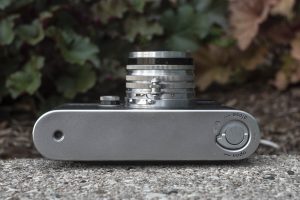
Since we’re talking about the bottom, there’s not much to see here other than a typical locking key for removing the bottom plate. Like all other screw mount Leicas and Leica copies, the Nicca III-L supports reloadable metal cassettes which use this key to open the close the cassette, protecting the film from light leaks when not in use. On the opposite side of the lock is a 1/4″ tripod socket. Normally, offset tripod sockets are not ideal as they don’t allow the camera to be properly balanced on a tripod, but this is normal for this style of camera.
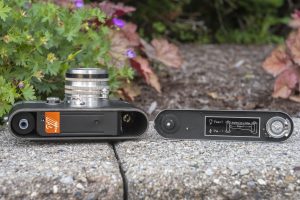
Remove the bottom plate and you can see into the film compartment. An orange sticker featuring a stylized Nicca III-L logo is the only place on the camera with it’s model name. Some sites on the internet incorrectly refer to this camera as the Nicca 3L, so if there’s any debate to it’s true name, this is it. A small pin, directly below this sticker is the exposure counter reset which I spoke of earlier. This pin relies on another smaller pin in the same position of the bottom plate, which means that only plates designed for this camera can be used. On the inside of the bottom plate is a black and chrome sticker reminding you to trim the leader to about 10 cm or 4 inches before installing it into the camera. It also reminds you of he flash sync speeds using flashbulbs (all speeds) or electronic flashes (1/30).
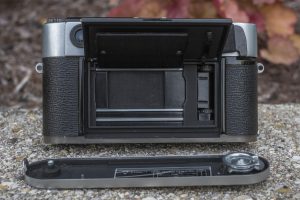
Around back, the Nicca III-L has the Leica M style film door which can be opened to see the film compartment, but only after removing the bottom plate. This style door was used on earlier Niccas, including the Tower 45 I previously reviewed. While some may see this as a necessity for loading film into a bottom loading camera, you still need to trim the leader to about 10cm before installing it, so it really doesn’t help making loading film that much easier. Once you get the hang of loading film into one of these cameras, you don’t really need the door. The one area in which this door is nice however, is the ability to see through the shutter to determine if the cloth curtains have any light leaks, something that’s not possible without a door.

On the door is a film reminder dial allowing you to select black and white ASA speeds from 32 to 800 and color ASA speeds from 10 to 100. A second dial allows you to choose whether the loaded film has 20 or 36 exposures, or whether it is empty. This dial is entirely for reference, and has no effect on the operation of the camera. Above the dial is the circular opening for the viewfinder, flash sync port, Nicca Camera Co. LTD and serial number engraving, and the film advance lever. The lever has some kind of highly textured tip on the end, making it very easy to grip.

On each side of the camera are metal strap lugs which are convenient as you do not have to rely on the original case if you want to use a neck strap. Also from the side, you get a sense of the camera’s height, as the revised top plate makes it a bit taller than an original Leica.
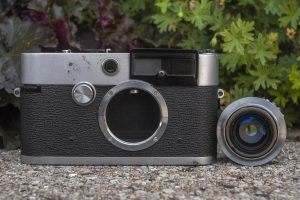
Up front, the Nicca III-L uses the standard M39 Leica Thread Mount and it supports nearly every LTM lens made. Righty tighty and lefty loosey are a good reminder for putting on and taking off the lens. Note that the Nikkor 5cm f/2 lens which is seen here and often found on these cameras has a minimum focus distance of 1.5 feet, but the Nicca is only rangefinder coupled down to 3.5 feet, meaning if you focus the lens closer to 3.5 feet, you can no longer rely on the rangefinder.
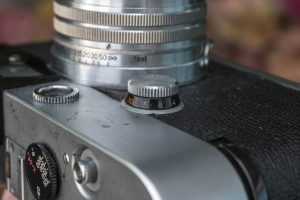
Above and to the left of the lens mount is the slow speed dial, with speeds from 1 to 1/30 plus T. In order to use this dial, you must set the top plate shutter speed dial to the “1-30” position. The slow speeds will not work unless the dial is in this position, so there’s no risk of accidentally setting them.
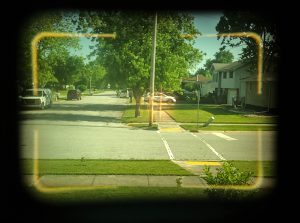
The Nicca’s viewfinder is very large and bright with excellent green and yellow contrast. Projected frame lines with automatic parallax correction estimate a 50mm image, and a rectangular rangefinder patch makes measuring accurate focus a breeze. The Nicca has no meter, nor is there any information about exposure visible in the viewfinder.
The Nicca III-L is an interesting camera as it offers a few modern upgrades, a clean and attractive design, yet doesn’t take anything away from the pure mechanical operation that users of Leica and Leica copies would be used to. Had you never handled one of these cameras, picking one up would require a very short learning curve as it’s operation is intuitive and familiar.
Combined with Nicca’s good reputation for quality, plus excellent Nikkor optics, there is nothing stopping you from making world class images as good as any out there. Of course, this is all in theory, how do things stack up when you actually load in some film and take it out shooting? Keep reading…
My Results
For the first roll of film in the Nicca III-L, I chose a roll of expired Kodak Gold 100. I had come across a large supply of this film last summer and although heavily expired, previously, I had gotten usable images from it with only a moderate amount of color shift. I do not know if these rolls were all stored differently, but as I kept shooting it, I found that each roll aged differently from others. Some were decently passable, others had huge color shifts. This particular roll was one of the bad ones, returning heavily magenta and cyans with hardly any other color. I tried my best to color balance them to salvage what I could, but in the end, I got better results by grayscaling them in Photoshop. I used the Black and White Adjustment tool, applying a red filter to boost contrast in software.
Throughout their history, Nicca did a lot of things right. Instead of changing a known formula that was already successful with the Leica III, they created a camera with nearly the same level of refinement and quality, but for a fraction of the price. In my time collecting, I’ve been told by those who service cameras, that when comparing Niccas to the real thing, the comparison is very favorable.
When Nicca did start to make changes, such as with the film advance knob, rear film door, and relocating the shutter button closer to the front of the camera, it’s changes were meaningful and welcomed. They weren’t a company known for rocking the boat, and adding unnecessary features or egregious designs.
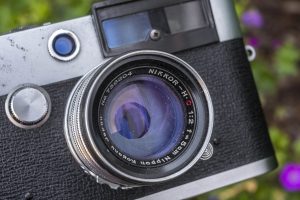
Perhaps the best thing they did right, was pair themselves with Nikkor lenses. Of course any Nikkor lens in Leica Thread Mount can be used on any LTM camera, but Nicca never wasted their time trying to make their own lenses. Why compete with a winning formula, when you already have it? Many Nicca cameras from the earliest Tower models through this III-L came usually with a 50mm f/2 or f/1.4 lens. Each of these lenses has some of the finest optics of any maker in the world, and when mounting a Nikkor lens to a Nicca camera, you are assured of world class images that can’t be beat by anyone.
So when looking at the sample pics I got from my example, of course they look great. Images are sharp corner to corner, with just the right amount of contrast. Although I grayscaled the color film on my inaugural roll, I can’t at all blame it on the lenses. In fact, the exact same lens you see here is the same one I used to test my Tower 45 so if you want to see how it performs on good color film, you can check there, but I’ll just tell you, it’s excellent.
As the biggest reason to consider a model like the III-L is it’s updated looks, I’ll definitely agree that whoever came up with this design hit it out of the park. I love the minimalist design and I think that only including the “NICCA” name in thin capital letters in white lettering on a black background was a genius move. I also like that they didn’t plaster model numbers, or other company logos on the front plate, offering a clean and clutter free minimalist design.
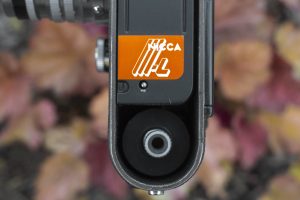
By the time of this model’s release, combined coincident image coupled rangefinders were the norm, and it’s good to see Nicca excel here as the included viewfinder has the perfect amount of contrast, is the right size even for people with prescription glasses, and wisely includes automatic parallax correction. I would have liked to see some innovation perhaps showing shutter speeds or something else in the viewfinder, but no one else was doing it then, so maybe there’s a reason for that. The inclusion of the automatic resetting exposure counter is a nice touch as I NEVER remember to reset it on other screw mount cameras, and getting it to work on a bottom loader is pretty cool. Lastly, I applaud Nicca’s decision to not forego the strap lugs, like so many other camera makers in the 1950s started to.
The Nicca III-L is an excellent camera that does everything it should without getting in the way with unnecessary features. If there’s one warning I’ll give potential buyers of this camera however, is that they’re expensive, and once you get over it’s great looks and nice viewfinder, you won’t find the shooting experience much different from significantly cheaper LTM cameras. I think a better way to say that is Nicca already had a winning formula, and for much less, you can get one of their earlier models, or a rebadged Tower that is going to work just as good, and make just as great of images, for quite a bit less. Sure, with the III-L, you get a pretty face, and a bit of “gee-whiz” exclusivity, but beyond that, it’s just lipstick and mascara.
Related Posts You Might Enjoy
External Links
http://camera-wiki.org/wiki/Nicca_III-L
http://www.yashicatlr.com/Nicca.html#niccaIII-l
https://www.canonrangefinder.org/Nicca_Cameras.htm

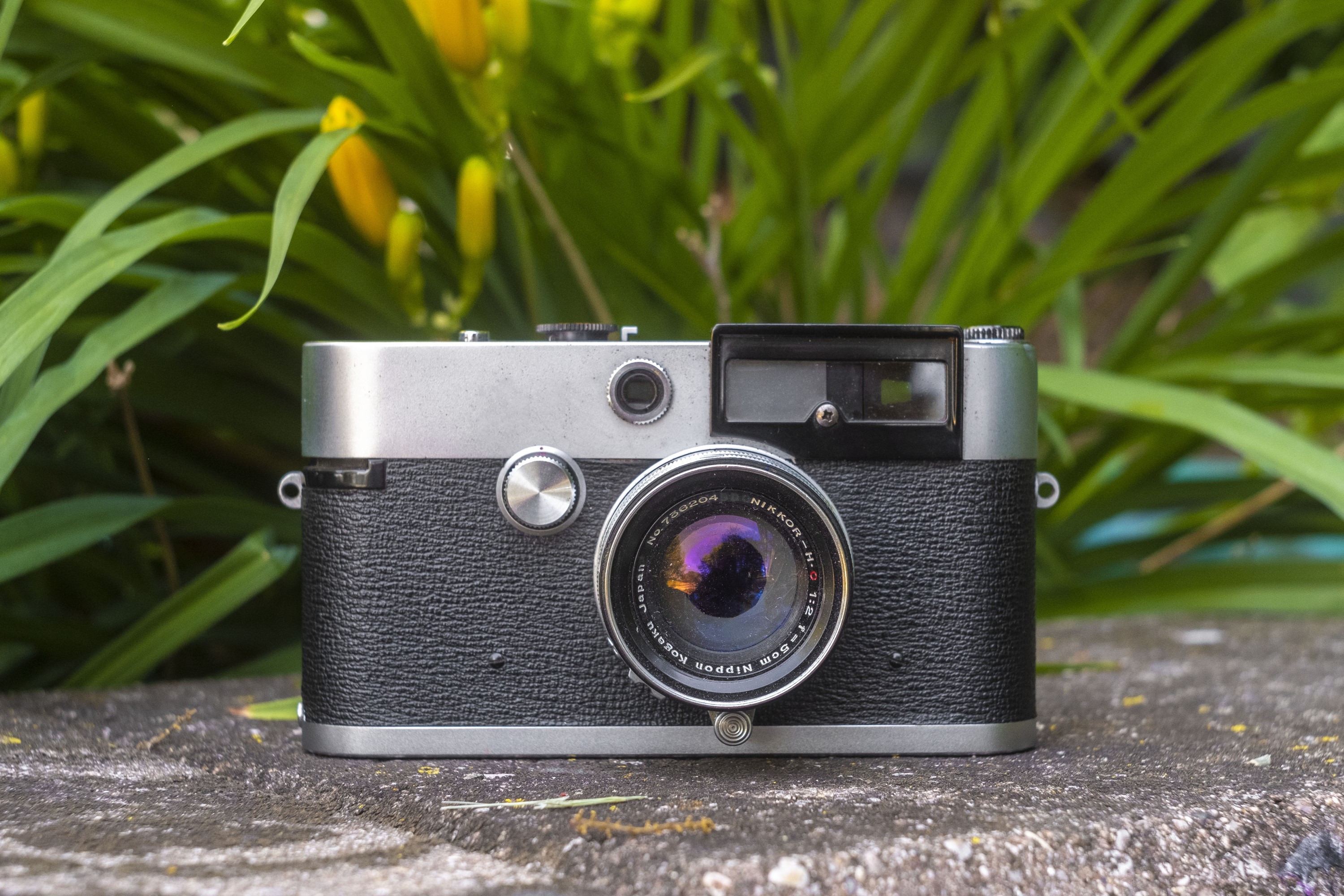


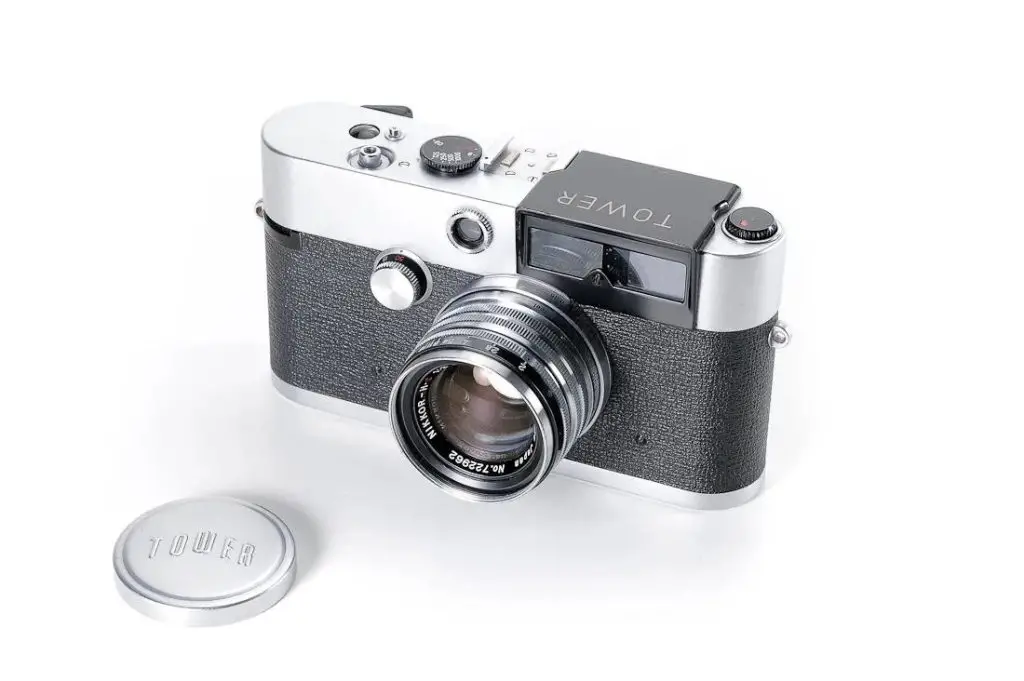
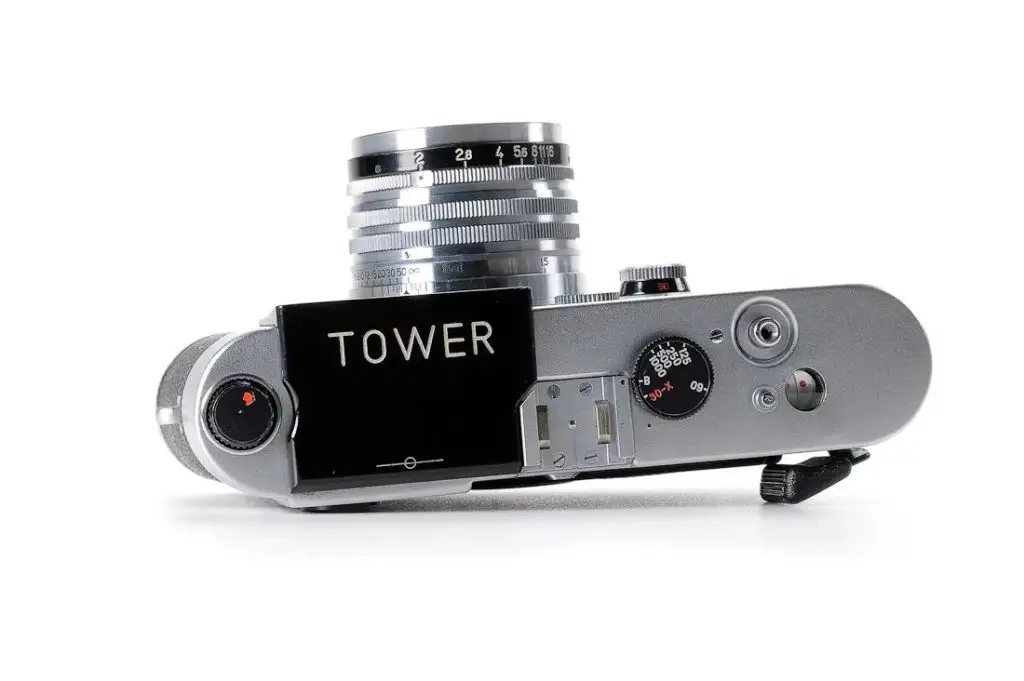
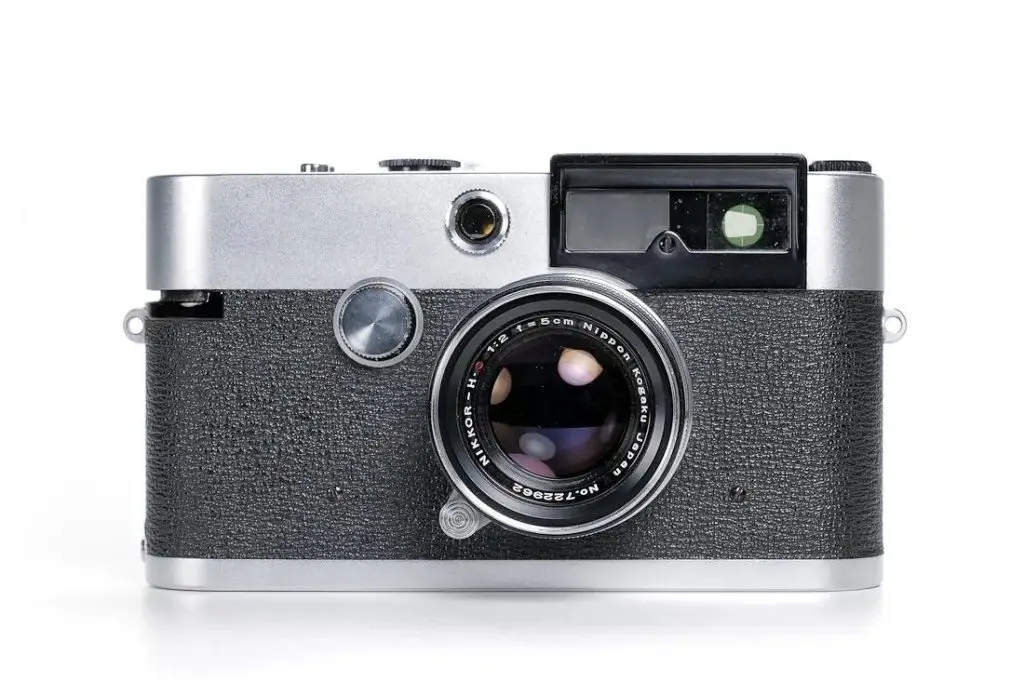

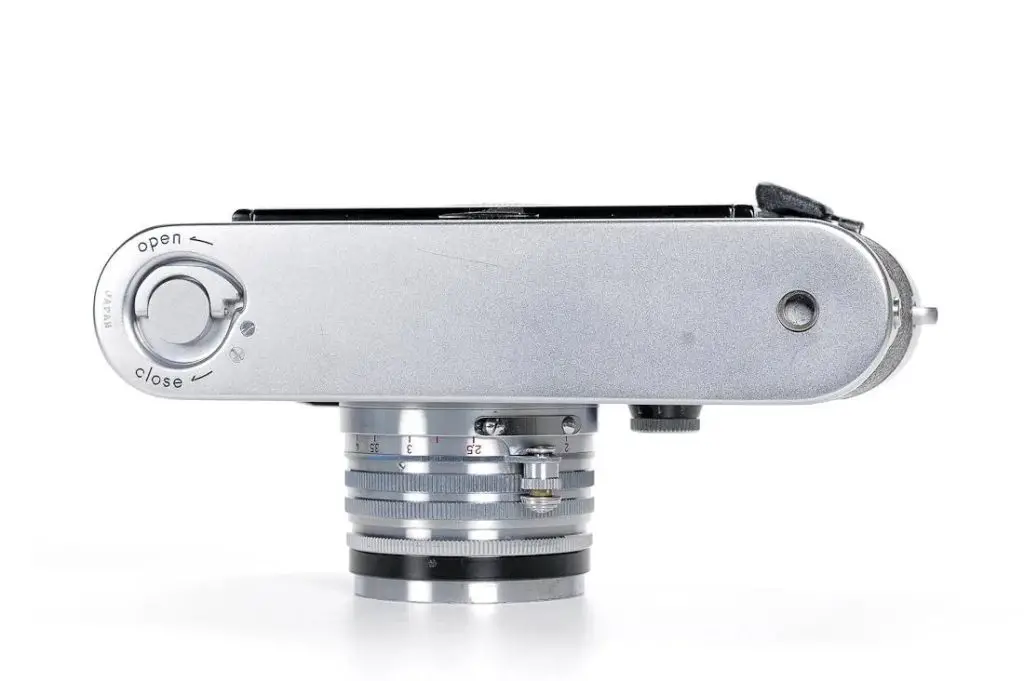





















Very nice review! However, even though the diagram shows it, you don’t have to trim the film before loading. That’s why they have the flip up door like a Leica M3. I have a Tower 45 with a flip up door, and I never trim the film. It works great without damaging the shutter curtain or the film. You might not have to do that on the Nicca III L either. Give it a try with your expired film.